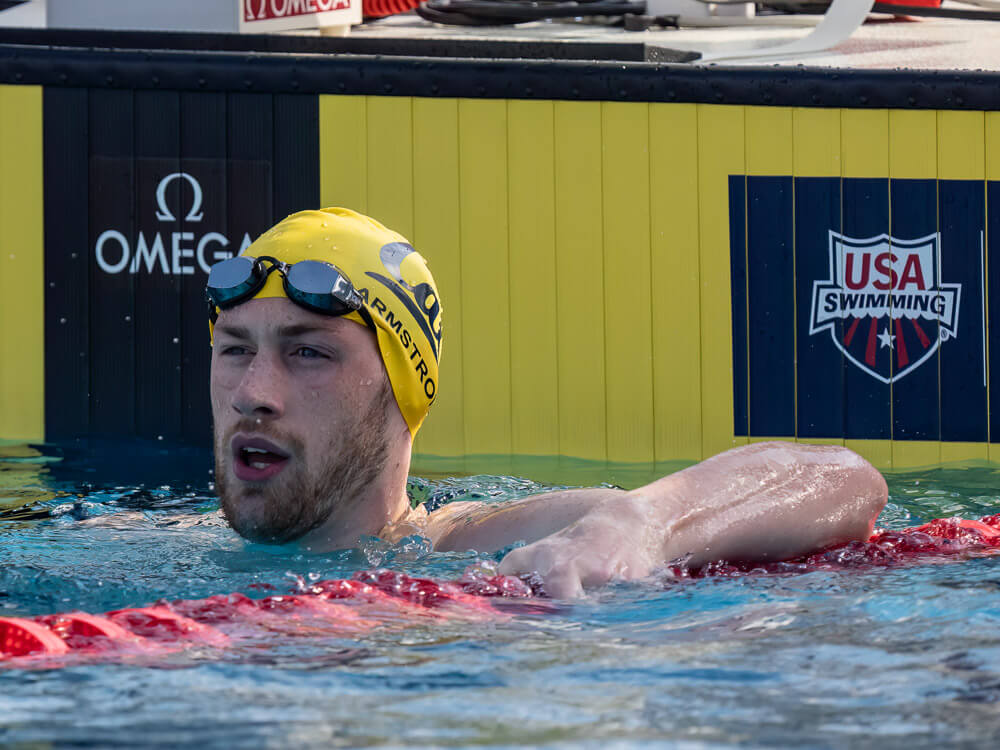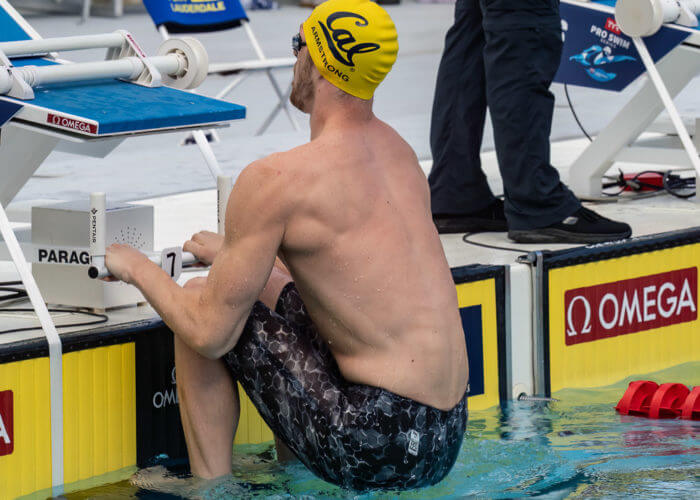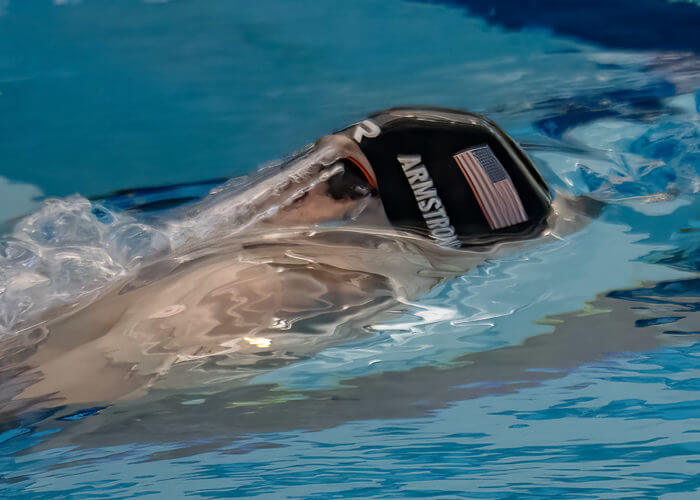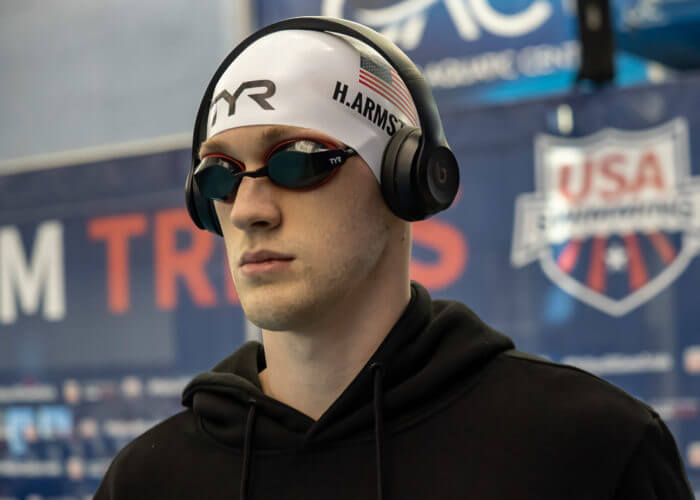Hunter Armstrong Seeking To Take Rising Star to Even Greater Heights

Hunter Armstrong Seeking To Take Rising Star to Even Greater Heights
Hunter Armstrong made a surge that most swimmers can only dream of. He began his college swimming career without having achieved much success on a national level, and less than two years later, he became an Olympian. Now, two years further down the line, Armstrong is a professional swimmer, a world record holder and a world champion with no plans of slowing down anytime soon.
During Hunter Armstrong’s first college season at West Virginia University in August 2019, massive time drops allowed him to earn one of the last qualifying spots for the 2020 NCAA Championships, a meet that would be canceled due to the onset of the COVID-19 pandemic. Weeks after that NCAA meet would have happened, Armstrong announced he was transferring to Ohio State, and during his first season as a Buckeye, further time drops transformed him into an NCAA consolation finalist.
But these improvements, while certainly impressive, were no indication that Armstrong was about to make the jump to Olympic-level backstroker. At that point, he still considered himself primarily a sprint freestyler. However, at the 2021 TYR Pro Swim Series in Indianapolis, Armstrong made a statement in the 100 backstroke, knocking a second off his best time (54.74 to 53.69) and defeating 2012 Olympic champion Matt Grevers in the event.

Photo Courtesy: Peter H. Bick
One month later in Omaha, Neb., Armstrong arrived at his first Olympic Trials and immediately made an impression. Another best time in prelims qualified him sixth for the semifinals, and he broke 53 for the first time that evening to qualify second for the final, earning a lane next to defending Olympic champion and current world record holder Ryan Murphy.
“I never really thought I was going to be an Olympian,” Armstrong said. “It wasn’t until the semifinals at Trials where I considered that I might have a shot. My goal going into Olympic Trials was just to make the national team, so I wanted to be top-six. I ended up having a really good semifinal, going in second seed, and that’s when it hit me: ‘Tomorrow, I fight for my shot at Tokyo.’ I never dreamt of being an Olympian. I didn’t think it was something achievable for me until that night when it happened.”
The next night, Armstrong flipped seventh at the halfway point, his longshot chances at Tokyo seemingly slipping away, but then he surged, picking off his competitors one by one. Among them were Grevers and Shaine Casas, the NCAA champion in the 100 yard back, and he nearly caught Murphy, finishing only 15-hundredths behind the longtime star.
His second-place finish in the final, in a time of 52.48, was among the most stunning results of the all-important selection meet, and it would not be the last time Armstrong would stun an American crowd naïve enough to underestimate his potential.
“THERE MIGHT BE SOMETHING HERE”
At the next U.S. selection meet, with spots on the 2022 World Championships team up for grabs, Armstrong asked his coach, Matt Bowe, to scratch him out of the 50 back. Armstrong had already pulled off another surprising qualification at that meet, tying for fourth in the 100 free on the second day of the meet after his closing split of 24.90 was the quickest in the entire field. He was already headed to the World Championships as a member of the American men’s 400 free relay.
So why bother with the 50 back, a race he hardly ever swam? Armstrong quickly found a reason in prelims, when he swam a time of 24.01 to crush Murphy’s previous American record of 24.24. “I was like, ‘Oh, OK. There might be something here,’” he said.

Photo Courtesy: Peter H. Bick
That night, he broke the world record, swimming a time of 23.71 to beat Kliment Kolesnikov’s previous mark by 9-hundredths. It was a 50-meter sprint, not considered as significant event as one contested in the Olympic Games, but Armstrong became the only the second American man since 2016 to set an individual long course world record, joining the likes of Caeleb Dressel. And one day later, Armstrong outpaced an impressive field (including Murphy) to win the 100 back, his mark of 52.20 another best time.
While Armstrong had proved his abilities beyond a doubt at selection meets, he had underperformed in his first international appearance. His Olympic debut could not match his successful Trials, with Armstrong ending up tied for ninth in the 100 back, 1-hundredth away from eighth place and a spot in the final. He later earned a gold medal as the prelims backstroke swimmer on the 400 medley relay.
At the Olympics, Armstrong was caught off guard by the feeling of representing the United States for the first time, “and that carried a lot of pressure that I wasn’t prepared for,” he said. Moreover, his inexperience in racing at major meets showed. Armstrong realized that he could not simply depend on his coaches to lead the way constantly; there were routines he needed to master.
“Just having to take ownership of my own career,” Armstrong said. “It’s not as simple as going to a meet and Matt’s there telling me how to warm up: ‘Be in the lobby at this time. Get in the car. We’re leaving.’ I have to find my way to the pool, get there with enough time, warm up on my own, warm down on my own. That’s a lot of stuff that I had relied on my coaches to help me with.”
2022 WORLD CHAMPIONSHIPS
Armstrong would have a chance to put his experience to use when he returned to international swimming at the 2022 World Championships. After swimming prelims of the 400 free relay—and receiving a gold medal when the American men finished first in the final—Armstrong qualified for the 100 back final and then swam under 52 for the first time. His time of 51.98 would have tied for Olympic gold one year earlier, although this time he settled for bronze behind Italy’s Thomas Ceccon, who set a world record, and Murphy.

Photo Courtesy: Peter H. Bick
The next day, Armstrong expected a day off from racing, but a last-minute change to the U.S. mixed 400 medley relay squad meant Caeleb Dressel was off, and Armstrong got the call for the backstroke leg. He combined with breaststroker Nic Fink, butterflyer Torri Huske and freestyler Claire Curzan to produce gold for the U.S., finishing more than two-and-a-half seconds clear of second-place Australia.
“When everything went down, I was in my hotel room, bag packed, ready to go just swim easy, and (Ohio State head coach) Bill (Dorenkott) calls me. He’s like, ‘Do you have a tech suit?’ I’m like, ‘Yes.’ It’s like, ‘OK, you’re on the relay tonight.’ I’m like, ‘All right. OK then, let’s do it,’” Armstrong said. “I couldn’t have asked for a better relay.”
Finally, Armstrong won a silver medal in the 50 back, finishing just behind American teammate Justin Ress. Armstrong briefly was named the gold medalist when Ress was disqualified for an illegal finish, but the DQ was overturned after video review, and in a classy display, Armstrong readily surrendered his gold medal.
“I’d like to think that the majority of people put in that same situation would act the same,” Armstrong said. “As much as it sucked to lose the event that you have the world record in, Justin swam better. It’s a 50. It’s whoever makes the least amount of mistakes, and I made one or too many more. Justin got the better of me, and he got that medal.”
TURNING PRO
Today, Armstrong is the rare swimmer to get a close-up view of three different U.S. college swimming programs. In 2022, he decided to surrender his remaining college eligibility to turn professional, and he chose to train at Cal, following Bowe after the sprint coach had accepted an associate head coaching position on Dave Durden’s staff with the Bears. Less than a year in, Armstrong can tell why Cal has become one of the country’s dominant men’s programs, including another national title this year.
“I had a chance to work with Dave (Durden) a little bit during Tokyo, so I sort of had a sneak-peak of what I was getting myself into, but let me tell you, the culture here is unmatched,” Armstrong said. “I was really worried going in, especially being the first non-Cal pro, but they accepted me with open arms. It’s just really cool to be a part of three—technically, not ‘a part’ of this college program, but I get to train with them. I get to see tiny differences that every school does, and I couldn’t be in a better place.”
As Armstrong prepares for the U.S. Nationals later this month, June 27-July 1—which will also serve as the U.S. national team selection event for upcoming 2023 events (including the World Championships in Fukuoka, Japan)—the 22-year-old makes sure to keep his goals realistic—“I don’t want to be a world record holder in the 200 breaststroke. I’ve never swum that event for a reason,” he quipped—but still ambitious.
“I define success as being the best that you can be at any given time,” Armstrong said. “If you’re really struggling in practice, it’s not a failed practice. If you did everything that you could for that day, it’s successful. What drives me is to be the best that I can be.”





Good Luck next week Hunter!!